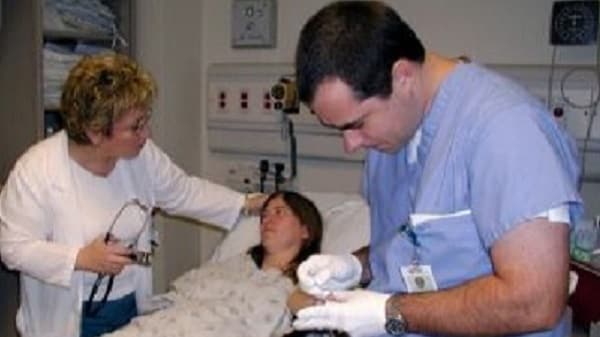At a glance
- Obtain a recent travel history from febrile patients.
- Always confirm a clinical diagnosis of malaria with a laboratory test.
- Rapid diagnosis of malaria and accurate identification the parasite species is integral to the appropriate treatment of affected individuals.
- Follow-up testing by microscopy is also recommended to ensure parasite clearance following treatment completion.
Considerations
Healthcare providers should always obtain a travel history (past 12 months) from febrile patients. Fever in a person who has recently traveled in a malaria-endemic area should always be immediately evaluated using the appropriate diagnostic tests for malaria.
Determining an approach
Laboratory Diagnosis
Rapid and accurate diagnosis of malaria is integral to the appropriate treatment of affected individuals and in preventing the further spread of infection in the community.
Malaria should be considered a potential medical emergency. Delay in diagnosis and treatment is a leading cause of death in malaria patients in the United States.
Malaria can be suspected based on the patient's travel history, symptoms, and the physical findings at examination. However, for a definitive diagnosis to be made, laboratory tests must demonstrate the malaria parasites or their components.

Diagnosis of malaria can be difficult:
- Where malaria is not endemic anymore (such as in the United States), health-care providers may not be familiar with the disease. Clinicians seeing a malaria patient may forget to consider malaria among the potential diagnoses and not order the needed diagnostic tests. Laboratorians may lack experience with malaria and fail to detect parasites when examining blood smears under the microscope.
- In some malaria-endemic areas, malaria transmission is so intense that a large proportion of the population is infected but not made ill by the parasites. Such carriers have developed just enough immunity to protect them from malarial illness but not from malarial infection. In that situation, finding malaria parasites in an ill person does not necessarily mean that the illness is caused by the parasites. In the US, symptomatic and asymptomatic infections should be treated.
As a national reference center for malaria diagnosis, CDC provides diagnostic and technical assistance on malaria diagnosis. CDC provides reference microscopic diagnosis and other specialized tests such as PCR. Additionally, telediagnosis and training are provided for malaria and other parasitic diseases on CDC's DPDx website. Public health laboratories may also conduct malaria diagnostic testing, healthcare providers should check with their health departments for assistance with testing and/or specimen submission to CDC.
Clinical diagnosis
Clinical findings should always be confirmed by a laboratory test for malaria.
In addition to ordering the malaria specific diagnostic tests described below, the health-care provider should conduct an initial workup and request a complete blood count and a routine chemistry panel. In the event that the person does have a positive malaria test, these additional tests will be useful in determining whether the patient has uncomplicated or severe manifestations of the malaria infection. Specifically, these tests can detect severe anemia, hypoglycemia, renal failure, hyperbilirubinemia, and acid-base disturbances. If the patient has traveled to an area with Plasmodium vivax transmission, testing for G6PD deficiency early in the evaluation would expedite the ability to administer treatment for the dormant liver stages (required for P. vivax and P. ovale malaria).
Microscopic Diagnosis
Malaria parasites can be identified by examining under the microscope a drop of the patient's blood, spread out as a "blood smear" on a microscope slide. Prior to examination, the specimen is stained (most often with Giemsa stain) to give the parasites a distinctive appearance. This technique remains the gold standard for laboratory confirmation of malaria parasites. However, it depends on the quality of the reagents, of the microscope, the blood smear, and on the experience of the laboratorian. A negative blood smear makes the diagnosis of malaria unlikely. However, because non-immune individuals may be symptomatic at very low parasite densities which may be initially undetectable, blood smears should be repeated every 12–24 hours for a total of three sets before the diagnosis of malaria can be ruled out.
Antigen Detection
In the international setting, various test kits are available to detect antigens derived from malaria parasites. Such immunologic ("immunochromatographic") tests most often use a dipstick or cassette format and provide results in 2-15 minutes. These "Rapid Diagnostic Tests" (RDTs) offer a useful alternative to microscopy in situations where reliable microscopic diagnosis is not available. Malaria RDTs are currently used in some clinical settings and programs. On June 13, 2007, the U.S. Food and Drug Administration (FDA) approved the first RDT for use in the United States. This RDT is approved for use by clinical laboratories, not by individual clinicians or by patients themselves. It is recommended that all RDTs are followed-up with microscopy to confirm the results and if positive, to confirm the species and quantify the proportion of red blood cells that are infected. The use of this RDT may decrease the amount of time that it takes to determine whether a patient is infected with malaria.
Molecular diagnosis
Parasite nucleic acids are detected using polymerase chain reaction (PCR). Although this technique may be more sensitive than blood smear microscopy, it is of limited utility for the diagnosis of acutely ill patients in the standard healthcare setting. PCR results are often not available quickly enough to be of value in establishing the diagnosis of malaria infection.
PCR is most useful for confirming the species of malarial parasite after the diagnosis has been established by either smear microscopy or RDT. Read more on molecular diagnosis of malaria and babesiosis.
CDC conducts surveillance for antimalarial (drug) resistance.
